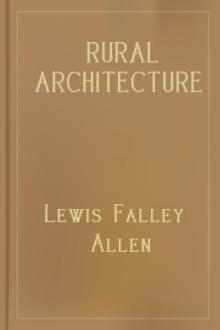Rural Architecture, Lewis Falley Allen [8 ebook reader .txt] 📗

- Author: Lewis Falley Allen
- Performer: -
Book online «Rural Architecture, Lewis Falley Allen [8 ebook reader .txt] 📗». Author Lewis Falley Allen
"How doth the little busy bee," &c. &c.,
we have long ago set it down as incorrigible to kind treatment, or charitable sympathy, and looked upon it simply as a thing to be treated kindly for the sake of its labors, and as composing one of that delightful family of domestic objects which make our homes attractive, pleasant, and profitable.
The active labors of the bee, in a bright May or June morning, as they fly, in their busy order, back and forth from their hives, or the soothing hum of their playful hours, in a summer's afternoon, are among the most delightful associations of rural life; and as a luxury to the sight, and the ear, they should be associated with every farmer's home, and with every laborer's cottage, when practicable. And as their due accommodation is to be the object of our present writing, a plan is presented for that object.
In many of the modern structures held out for imitation, the bee-house, or apiary, is an expensive, pretentious affair, got up in an ambitious way, with efforts at style, in the semblance of a temple, a pagoda, or other absurdity, the very appearance of which frightens the simple bee from its propriety, and in which we never yet knew a colony of them to become, and remain successful. The insect is, as we have observed, wild and untamable—a savage in its habits, and rude in its temper. It rejects all cultivated appearances, and seeks only its own temporary convenience, together with comfortable room for its stores, and the increase of its kind; and therefore, the more rustic and simple its habitation, the better is it pleased with its position.
The bee-house should front upon a sheltered and sunny aspect. It should be near the ground, in a clean and quiet spot, free from the intrusion of other creatures, either human or profane, and undisturbed by noisome smells, and uncouth sounds—for it loathes all these instinctively, and loves nothing so much as the wild beauty of nature itself. The plan here presented is of the plainest and least expensive kind. Nine posts, or crutches, are set into the ground sufficiently deep to hold them firm, and to secure them from heaving out by the frost. The distance of these posts apart may be according to the size of the building, and to give it strength enough to resist the action of the wind. The front posts should be 9 feet high, above the ground; the rear posts should be 7 feet—that a man, with his hat on, may stand upright under them—and 6 feet from the front line. The two end posts directly in the rear of the front corner posts, should be 3 feet back from them, and on a line to accommodate the pitch of the roof from the front to the rear. A light plate is to be fitted on the top line of the front posts; a plate at each end should run back to the posts in rear, and then another cross-plate, or girt, from each one of these middle posts, to the post in rear of all, to meet the plate which surmounts this rear line of posts; and a parallel plate, or rafter, should be laid from the two intermediate posts at the ends, to connect them, and for a central support to the roof. Intermediate central posts should also be placed opposite those in front, to support the central plate, and not exceeding 12 feet apart. A shed roof, of boards, or shingles, tightly laid, should cover the whole, sufficiently projecting over the front, rear, and sides, to give the house abundant shelter, and make it architecturally agreeable to the eye—say 12 to 18 inches, according to its extent. A corner board should drop two feet below the plate, with such finish, by way of ornament, as may be desirable. The ends should be tightly boarded up against the weather, from bottom to top. The rear should also be tightly boarded, from the bottom up to a level with the stand inside, for the hives, and from 15 to 18 inches above that to the roof. Fitted into the space thus left in the rear, should be a light, though substantial, swing door, hung from the upper boarding, made in sections, extending from one post to the other, as the size of the house may determine, and secured with hooks, or buttons, as may be convenient. The outside of the structure is thus completed.
The inside arrangement for the hives, may be made in two different ways, as the choice of the apiarian may govern in the mode in which his hives are secured. The most usual is the stand method, which may be made thus: At each angle, equidistant, say 18 to 24 inches, inside, from the rear side and ends of the building—as shown in the ground plan—and opposite to each rear and end post, suspend perpendicularly a line of stout pieces of two-inch plank, 4 inches wide, well spiked on to the rafters above, reaching down within two feet of the ground—which is to hold up the bottom of the stand on which the hives are to rest. From each bottom end of these suspended strips, secure another piece of like thickness and width, horizontally back to the post in rear of it, at the side and ends. Then, lengthwise the building, and turning the angles at the ends, and resting on these horizontal pieces just described, lay other strips, 3×2 inches, set edgewise—one in front, and another in rear, inside each post and suspended strip, and close to it, and secured by heavy nails, so that there shall be a double line of these strips on a level, extending entirely around the interior, from the front at each end. This forms the hanging frame-work for the planks or boards on which the hives are to rest.
Now for the hives. First, let as many pieces of sound one and a half, or two-inch plank as you have hives to set upon them, be cut long enough to reach from the boarding on the rear and ends of the building, to one inch beyond, and projecting over the front of the outer strip last described. Let these pieces of plank be well and smoothly planed, and laid lengthwise across the aforesaid strips, not less than four inches apart from each other—if a less number of hives be in the building than it will accommodate at four inches apart, no matter how far apart they may be—these pieces of plank are the ferms for the hives, on which they are to sit. And, as we have for many years adopted the plan now described, with entire success, a brief description is given of our mode of hive, and the process for obtaining the surplus honey. We say surplus, for destroying the bees to obtain their honey, is a mode not at all according to our notions of economy, or mercy; and we prefer to take that honey only which the swarm may make, after supplying their own wants, and the stores for their increasing family. This process is given in the report of a committee of gentlemen appointed by the New York State Agricultural Society, on a hive which we exhibited on that occasion, with the following note attached, at their show at Buffalo, in 1848:
"I have seen, examined, and used several different plans of patent hive, of which there are probably thirty invented, and used, more or less. I have found all which I have ever seen, unsatisfactory, not carrying out in full, the benefits claimed for them. "The bee works, and lives, I believe, solely by instinct. I do not consider it an inventive, or very ingenious insect. To succeed well, its accommodations should be of the simplest and securest form. Therefore, instead of adopting the complicated plans of many of the patent hives, I have made, and used a simple box, like that now before you, containing a cube of one foot square inside—made of one and a quarter inch sound pine plank, well jointed and planed on all sides, and put together perfectly tight at the joints, with white lead ground in oil, and the inside of the hive at the bottom champered off to three-eighths of an inch thick, with a door for the bees in front, of four inches long by three-eighths of an inch high. I do this, that there may be a thin surface to come in contact with the shelf on which they rest, thus preventing a harbor for the bee-moth. (I have never used a patent hive which would exclude the bee-moth, nor any one which would so well do it as this, having never been troubled with that scourge since I used this tight hive.) On the top of the hive, an inch or two from the front, is made a passage for the bees, of an inch wide, and six to eight inches long, to admit the bees into an upper hive for surplus honey, (which passage is covered, when no vessel for that purpose is on the top.) For obtaining the honey, I use a common ten or twelve-quart water pail, inverted, with the bail turned over, in which the bees deposit their surplus, like the sample before you. The pail will hold about twenty pounds of honey. This is simple, cheap, and expeditious; the pail costing not exceeding twenty-five cents, is taken off in a moment, the bail replaced, and the honey ready for transportation, or market, and always in place. If there is time for more honey to be made, (my bees made two pails-full in succession this year,) another pail can be put on at once. "Such, gentlemen, in short, is my method. I have kept bees about twenty years. I succeed better on this plan than with any other."In addition to this, our hives are painted white, or other light color, on the outside, to protect them from warping, and as a further security against the bee-moth, or miller, which infests and destroys so many carelessly-made hives, as to discourage the efforts of equally careless people in keeping them. Inside the hive, on each end, we fasten, by shingle nails, about half-way between the bottom and top, a small piece of half-inch board, about the size of a common window button, and with a like notch in it, set upward, but stationary, on which, when the hive is to receive the swarm, a stick is laid across, to support the comb as it is built, from falling in hot weather. At such time, also, when new, and used for the first time, the under-side of the top is scratched with the tines of a table fork, or a nail, so as to make a rough surface, to which the new comb can be fastened. In addition to the pails on the top of the hives, to receive the surplus honey, we





Comments (0)